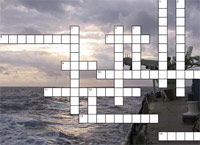|

 Today's Weather Mostly cloudy Lat: 04° 02’S Long: 12° 14’W Air Temp: 77.8°F Bar Pressure: 1009.9 mbar Sea Temp: 79.5°F Sea State: 6-8 ft Swell Height: <7 ft, SE Wind: SSE; 15-17 knots Visibility: Unlimited
Try the new AUV Communications
Come Home, Jaguar! Working at the cutting edge of technology development is not for the faint-hearted or the weak-kneed. That lesson was hammered home again last night. Despite our solid preparation and best-laid plans, we encountered more unexpected problems. “There are two million ways an AUV can go wrong,” explained geophysicist Rob Reves-Sohn, “but only one way for it to go right. And that is if everything works.” Everything worked like clockwork until just after midnight, when Jaguar—which went on its first mission of this cruise to shoot digital pictures of the seafloor and collect high-resolution sonar data to make a map of the study site—was having trouble sticking to its programmed depth. Shortly after, the engineering team noticed that as it “flew” along its track line, Jaguar’s heading (the direction the vehicle is pointing) was constantly changing. Sometimes it pointed in the right direction, but other times it seemed to point the other way. Something was amiss. Even though it kept trying to run its programmed survey lines, Jaguar was heading in the wrong direction, and the distance between it and our study site grew longer and longer. Communications to the vehicle were sporadic, and although the engineers repeatedly sent the “abort” command—telling it to come home—Jaquar simply didn’t “hear” it. When the vehicle is close to the bottom, communications can be fuzzy because sound waves bouncing off the bottom interfere with sound waves traveling through the water. Finally, after it had traveled more than 8 kilometers (nearly 5 miles) away from the study site, the engineering team noticed that it was starting to float slowly toward the surface. Turns out, Jaguar’s batteries had died. Early this afternoon, Jaguar was safely back on deck. The engineers downloaded its “memory” and worked like detectives to piece the story back together again. What had happened? They learned that Jaguar’s vertical thruster stopped working, so it couldn’t stay at its programmed depth. To make matters worse, its port thruster then died. With only one main thruster left on its starboard (right) side, Jaguar was turning in circles, and that is why it was confusing the engineers by pointing in different directions. Working with underwater vehicles can be a frustrating business. Unlike your car or bike, which may have a few problems but still manage to keep going, everything has to work exactly right on an AUV. Tonight, the engineering team is busy figuring out what caused Jaguar’s thrusters to fail, while another group is preparing Puma for its second dive. Like with Jaguar, they know they have to get everything just right if the vehicle is going to succeed in its mission: to detect the upward-flowing plume of the hydrothermal vent we know is lurking below. And with time running out, they know they may not get another chance.Read the new interview Sarah Webster: Sarah Webster is a graduate student at Johns Hopkins University, now in her fourth year of a combined masters/Ph.D. program. She is part of the Dynamical Systems and Control Laboratory run by Prof. Louis Whitcomb in the Mechanical Engineering Department. Her research involves combined communications and navigation of multiple underwater vehicles. Read the interview »
[ Previous day ] [ Next day ]
|
||
Mailing List | Feedback | Glossary | For Teachers | About Us | Contact
© 2010 Dive and Discover™. Dive and Discover™ is a registered trademark of Woods
Hole Oceanographic Institution




